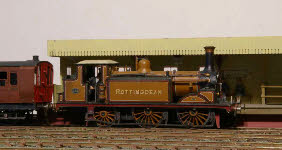



specials, with the engines going to nearby Lewes for coaling and watering – perhaps something else to add a bit of operational interest?
However, modelling the entire station, including these two lay-
I’ve not previously used Templot, but it’s the obvious choice for a new layout, so it’s time to shell out for a copy – except that logging onto the web-
One key component which I would like to include is a fully mechanically interlocked lever frame – something I’ve not attempted before, and which will certainly need some research – what to do and how to do it. The Signalling Record
 Society’s Book on LBSCR signal boxes shows the Plumpton Signalling Diagram for 1920, with the track plan and signalling unchanged from 1910. This shows that in addition to the main signal box to the east of the station, adjacent to the level crossing, there was also a ground frame in the goods yard, controlling signals and turnouts for the yard entry. I presume this is because the distance from the box to these turnouts was more than 250 yards, which the Brighton regarded as the limit for safe operation of turnouts. The box and the ground frame were linked by levers on the ground frame to request operation of the crossovers, and levers in the box which released bolt locks on the turnouts.
Society’s Book on LBSCR signal boxes shows the Plumpton Signalling Diagram for 1920, with the track plan and signalling unchanged from 1910. This shows that in addition to the main signal box to the east of the station, adjacent to the level crossing, there was also a ground frame in the goods yard, controlling signals and turnouts for the yard entry. I presume this is because the distance from the box to these turnouts was more than 250 yards, which the Brighton regarded as the limit for safe operation of turnouts. The box and the ground frame were linked by levers on the ground frame to request operation of the crossovers, and levers in the box which released bolt locks on the turnouts.The diagram very helpfully shows all the lever numbers, but doesn’t have any indication of how they were interlocked. Having spent a few days during the month thinking about this, and making numerous drafts of locking tables, and diagrams, I’m getting somewhere, but I’m not sure I’ve got it right.
July 2012. Templot is both brilliant, and frustrating in equal measure, especially if you’re used to ordinary CAD software. It takes a while to get used to the way in which the software generates track templates based on defined parameters, which can then be edited and saved. Creating a series of templates, and joining them together creates the final track plan. The best advice I got when I started, was to understand how pegs and notches work (they are the means by which adjacent templates can be seamlessly joined together). Excellent advice which got me up and running.
After a few day’s work I have managed to recreate the trackwork for Plumpton at true scale 4mm:1ft, but it is clearly too long. So what can be done? The most obvious change is to model only the crossovers into the lay-
 be shortened a bit further. The goods yard entry cannot be shortened without tightening the turnouts from B7 to B6, which I’m not prepared to risk in P4. A few further tweaks (making the level crossing slightly less acute for example) and on version 12 of my Templot track plan, I think I have just about achieved a solution – 16ft by 2ft scenic section, with four equal length baseboards, and pointwork which fits neatly relative to the base-
be shortened a bit further. The goods yard entry cannot be shortened without tightening the turnouts from B7 to B6, which I’m not prepared to risk in P4. A few further tweaks (making the level crossing slightly less acute for example) and on version 12 of my Templot track plan, I think I have just about achieved a solution – 16ft by 2ft scenic section, with four equal length baseboards, and pointwork which fits neatly relative to the base- I’ve decided to use interlaced sleepering for the turnouts which was a feature of the Brighton, although the photos I have of Plumpton don’t give a clear indication of whether it was used here or not. Learning how to move sleepers around, and create new ones in Templot has been a bit time consuming, but Templot is very flexible and once you get the hang of it, it’s quite straightforward, if a little long-
I’ve decided to use interlaced sleepering for the turnouts which was a feature of the Brighton, although the photos I have of Plumpton don’t give a clear indication of whether it was used here or not. Learning how to move sleepers around, and create new ones in Templot has been a bit time consuming, but Templot is very flexible and once you get the hang of it, it’s quite straightforward, if a little long- Plumpton has a rather curious dis-
Plumpton has a rather curious dis-A few miles west of Plumpton, close to Keymer junction is the Keymer Brick and Tile works, which had its own standard gauge railway, and also a connection to the main line. With a bit of modeller’s licence, brick making in Plumpton could conceivably have grown in size and stature to become ‘Plumpton Brick and Tile Works’, needing a connection to the main line…………
 With these two additions I think I now have a final track plan.
With these two additions I think I now have a final track plan.My idea for this layout is to make as much as possible (track, buildings, signals etc) before starting on the baseboards. I’m hoping that this will make the final assembly of the layout seem fairly quick, but we shall see.
I’ve had some fantastic help from Howard Bolton on the subject of interlocking, including the ins and outs of such seemingly obscure (but essential) topics of lifting tappets and sequential locking and I think I’m now getting somewhere with the locking table (ie what locks or releases what).